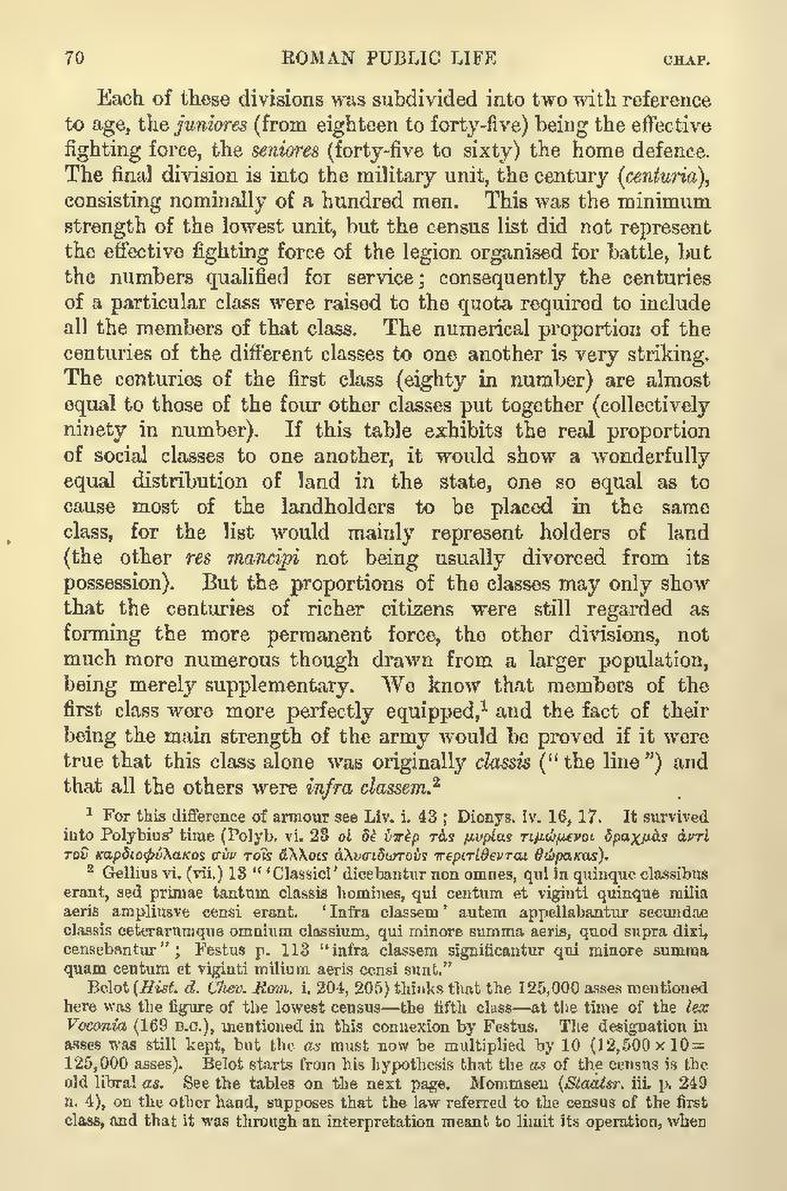Each of these divisions was subdivided into two with reference to age, the juniores (from eighteen to forty-five) being the effective fighting force, the seniores (forty-five to sixty) the home defence. The final division is into the military unit, the century (centuria), consisting nominally of a hundred men. This was the minimum strength of the lowest unit, but the census list did not represent the effective fighting force of the legion organised for battle, but the numbers qualified for service; consequently the centuries of a particular class were raised to the quota required to include all the members of that class. The numerical proportion of the centuries of the different classes to one another is very striking. The centuries of the first class (eighty in number) are almost equal to those of the four other classes put together (collectively ninety in number). If this table exhibits the real proportion of social classes to one another, it would show a wonderfully equal distribution of land in the state, one so equal as to cause most of the landholders to be placed in the same class, for the list would mainly represent holders of land (the other res mancipi not being usually divorced from its possession). But the proportions of the classes may only show that the centuries of richer citizens were still regarded as forming the more permanent force, the other divisions, not much more numerous though drawn from a larger population, being merely supplementary. We know that members of the first class were more perfectly equipped,[1] and the fact of their being the main strength of the army would be proved if it were true that this class alone was originally classis ("the line") and that all the others were infra classem.[2]).]*
- ↑ For this difference of armour see Liv. i. 43; Dionys. iv. 16, 17. It survived into Polybius' time (Polyb. vi. 23 [Greek: hoi de hyper tas myrias timômenoi drachmas anti tou kardiophylakos syn tois allois halysidôtous peritithentai thôrakas
- ↑ Gellius vi. (vii.) 13 "'Classici' dicebantur non omnes, qui in quinque classibus erant, sed primae tantum classis homines, qui centum et viginti quinque milia aeris ampliusve censi erant. 'Infra classem' autem appellabantur secundae classis ceterarumque omnium classium, qui minore summa aeris, quod supra dixi, censebantur"; Festus p. 113 "infra classem significantur qui minore summa quam centum et viginti milium aeris censi sunt." Belot (Hist. d. Chev. Rom. i. 204, 205) thinks that the 125,000 asses mentioned here was the figure of the lowest census—the fifth class—at the time of the lex Voconia (169 B.C.), mentioned in this connexion by Festus. The designation in asses was still kept, but the as must now be multiplied by 10 (12,500 x 10 = 125,000 asses). Belot starts from his hypothesis that the as of the census is the old libral as. See the tables on the next page. Mommsen (Staatsr. iii. p. 249 n. 4), on the other hand, supposes that the law referred to the census of the first class, and that it was through an interpretation meant to limit its operation, when
